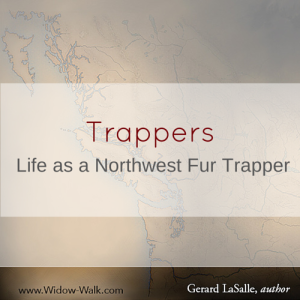Trappers: Life as a Northwest Fur Trapper
 The Widow Walk characters Rene Marte and Ebin Cull, as well as the denizens in the Red Pelican Inn, are Northwest trappers. Marte is a “Métis” the term that is used for people of First-Nation and European mixed race descent. Cull is a former African slave who has migrated north. These characters are typical of the men who lived in the Oregon Country’s northern territories in the eighteenth and nineteenth century. They supported themselves by trading in whatever commodities were valuable, including furs. Fur trading was hugely profitable because of the demand for animal pelts in China, Europe and the U.S. By late 1840’s however, many of the most valuable fur-bearing animals, like the sea otter, had been hunted to near extinction and the region was considered “trapped out.” Thus, the Metis and native traders found other commodities with which to make their living. In Widow Walk, slave trading has become profitable.
The Widow Walk characters Rene Marte and Ebin Cull, as well as the denizens in the Red Pelican Inn, are Northwest trappers. Marte is a “Métis” the term that is used for people of First-Nation and European mixed race descent. Cull is a former African slave who has migrated north. These characters are typical of the men who lived in the Oregon Country’s northern territories in the eighteenth and nineteenth century. They supported themselves by trading in whatever commodities were valuable, including furs. Fur trading was hugely profitable because of the demand for animal pelts in China, Europe and the U.S. By late 1840’s however, many of the most valuable fur-bearing animals, like the sea otter, had been hunted to near extinction and the region was considered “trapped out.” Thus, the Metis and native traders found other commodities with which to make their living. In Widow Walk, slave trading has become profitable.
- Fur trapping played a prominent role in the economy of the Pacific Northwest, seeing a decline in the 1840’s.
- Trappers were rugged, tough men whose daily way of living would be unsustainable for even the strongest of our present day American citizens.
- The quintessential trapper is portrayed as a weather beaten man wearing buckskin clothes, a fur hat, and sporting a long, bushy beard and mustache. In reality, though they did wear buckskin shirts and pants, they typically wore woolen hats and coats with moccasin or heavy boots, depending on the terrain they were navigating.
- They worked alone or in groups, carrying their hunting supplies, food, and kills with them, aided by a horse or mule to ride and a second to carry supplies and furs. Life in the wilderness was, not surprisingly, very difficult. Weather, wild animals, and illness all had to be overcome for survival and success. Even the strongest only made it a few seasons in the wild.
- They hunted game, fished, foraged, and took shelter in cabins.
- They developed friendly relationships with Native tribes, exchanging goods, food, and supplies with them.
- It was not unusual for a trapper to marry a Native American woman; she was sometimes bartered for between the trapper and tribe leader for a price.
Widow Walk, an American historical fiction novel illustrates the clash between Native American Indian tribe and white settlers in the Pacific Northwest. Stories based on real events told from the perspective of a militiaman, a native coming of age, and a bold pioneer wife weave together an unforgettable American adventure.